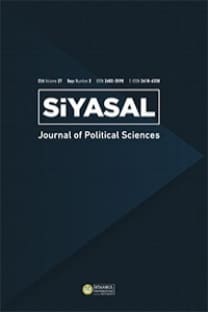Capital - Energy Substitution: Does Energy Sources Matter for the Elasticity of Substitution? An Empirical Investigation for OECD Countries
Energy and other factors of production are the primary inputs in the context of sustainable economic growth. This makes energy relatively strategic in the development stage and in the energy importers economies. In this study, the effect of elasticity of substitution on economic growth is investigated for 31 OECD countries over the period from 1990-2014. Although the effect of elasticity of substitution between capital and aggregate energy consumption on economic growth has been examined in many studies, the issue of how this effect changes between the different sources of energy has not been adequately addressed. The research is aimed at contributing to the related literature in this regard. The effect of elasticity of substitution between capital and different energy sources on economic growth is examined within the neoclassical Solow-Swan Growth model. In this model, technology is defined by a variable elasticity of substitution (VES) production function. The empirical model is estimated by the non-linear least squares (NLLS) method. The results show that oil and primary energy consumption are substitutes; natural gas, coal, and hydroelectricity consumption are the complement in the final production of output.
___
- Acemoglu, D. (2009). Introduction to modern economic growth. Princeton University Press.
- Apostolakis, B. E. (1990). Energy--capital substitutability/ complementarity: The dichotomy. Energy Economics, 12(1), 48‒58. https://doi.org/10.1016/0140-9883(90)90007-3
- Berndt, E. R., & Wood, D. O. (1975). Technology, Prices, and the Derived Demand for Energy. The Review of Economics and Statistics, 57(3), 259‒268.
- Blackorby, C., & Russell, R. R. (1989). Will the Real Elasticity of Substitution Please Stand Up? (A Comparison of the Allen/Uzawa and Morishima Elasticities). American Economic Review, 79(4), 882‒888.
- Chichilnisky, G. (1993). Energy-Capital Substitution: A General Equilibrium Analysis. SSRN Electronic Journal. https://doi.org/10.2139/ssrn.1374615
- Chumacero R. A. (2006). "Lecture notes on econometrics", manuscript, University of Chile.
- Costantini, V., & Paglialunga, E. (2014). Elasticity of substitution in capital-energy relationships: how central is a sector-based panel estimation approach? (SEEDS Working Papers No. 1314). SEEDS, Sustainability Environmental Economics and Dynamics Studies. https://ideas.repec.org/p/srt/wpaper/1314.html
- Deininger, S. M., Mohler, L., & Mueller, D. (2018). Factor substitution in Swiss manufacturing: empirical evidence using micro panel data. Swiss J Economics Statistics, 154(6). doi:10.1186/s41937-017-0016-5
- Feenstra, R. C., Inklaar, R., & Timmer, M. P. (2015). The Next Generation of the Penn World Table. American Economic Review, 105(10), 3150‒3182. doi: 10.1257/aer.20130954
- Griffin, J. M., & Gregory, P. R. (1976). An Intercountry Translog Model of Energy Substitution Responses. American Economic Review, 66(5), 845‒857.
- Haller, S. A., & Hyland, M. (2014). Capital-energy substitution: Evidence from a panel of Irish manufacturing firms. Energy Economics, 45, 501–510.
- Kim, J., & Heo, E. (2013). Asymmetric substitutability between energy and capital: Evidence from the manufacturing sectors in 10 OECD countries. Energy Economics, 40, 81–89.
- Lazkano, I., & Pham, L. (2016). Can Capital-Energy Substitution Foster Economic Growth? Land Economics, 92(3), 491–514. doi:10.3368/le.92.3.491
- Nguyen, S., & Strietwiesser, M. (1997). Capital-energy substitution revisited new evidence from micro data, Center for Economic Studies (CES), Research Paper 97/4.
- Özatalay, S., Grubaugh, S., & Long, T. V. (1979). Energy Substitution and National Energy Policy. The American Economic Review, 69(2), 369‒371.
- Palivos, T., & Karagiannis, G. (2010). The Elasticity of Substitution as an Engine of Growth. Macroeconomic Dynamics, 14(5), 617–628. https://doi.org/10.1017/S1365100509 000479
- Pindyck, R. S. (1979). Interfuel Substitution and the Industrial Demand for Energy: An International Comparison. The Review of Economics and Statistics, 61(2), 169‒179.
- Revankar, N. S. (1971). A Class of Variable Elasticity of Substitution Production Functions. Econometrica, 39(1), 61‒71. https://doi.org/10.2307/1909140
- Revankar, N. S. (1971). Capital-Labor Substitution, Technological Change, and Economic Growth: The U.S. Experience, 1929-1953. Metroeconomica, 23(2), 154–176. https://doi.org/10.1111/j.1467-999X.1971.tb00168.x
- Stern, D. I. (2011). The Role of Energy in Economic Growth, (SSRN Scholarly Paper No. ID 1878863). Rochester, NY: Social Science Research Network. https://papers.ssrn.com/abstract=1878863
- Thompson, P., & Taylor, T. G. (1995). The Capital-Energy Substitutability Debate: A New Look. The Review of Economics and Statistics, 77(3), 565‒569. https://doi.org/10.2307/2109916
- Tovar, M. A., & Iglesias, E. M. (2013). Capital-Energy Relationships: An Analysis when Disaggregating by Industry and Different Types of Capital. The Energy Journal, 34(4), 129‒150.
- van Zon, A., & Yetkiner, I. H. (2003). An endogenous growth model with embodied energy-saving technical change. Resource and Energy Economics, 25(1), 81‒103. https://doi.org/10.1016/S0928-7655(02)00018-0.
- Yayın Aralığı: Yılda 2 Sayı
- Başlangıç: 1983
- Yayıncı: İstanbul Üniversitesi
Sayıdaki Diğer Makaleler
2011 Sonrasında Türkiye-Mısır İlişkilerinde Yaşanan Ani Yükseliş ve Sert Düşüşü Anlamak
Ömer Faruk ALTUNÇ, Abdulmecit YILDIRIM
Para Politikasi ve Döviz Kuru Dinamikleri:Türk Lirasinda Siçrama Etkisi Geçerli Mi?
Bilge Kağan ÖZDEMİR, İlyas ŞIKLAR
Türkiye’de Yönetimler Arası Transferlerin Kişi Başı Gelir Üzerindeki Etkisi: Panel Veri Analizi
Avrupa Birliği’ne Üyelik Sürecinde Türk Kamu Yönetiminin Kurumsal Kapasitesi
Uğur SADİOĞLU, Yasemin ÇİFCİ, Emre EZİN, Betül DİNÇ
Propagandanın Taşrada İnşası: 27 Mayıs 1960 Sonrası Köylerdeki Propaganda Faaliyetleri
Siyaset Psikolojisi Perspektifinden Türk Milliyetçiliği: Gökalp’i Yeniden Düşünmek
“Sosyal Kaçakçılık”: Erken Cumhuriyet Türkiyesi’nde Tekellere Direniş
